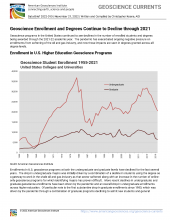The percentage of geoscience graduate degrees conferred from U.S. institutions to non-U.S. residents has increased from ~25% during 1995-2000 to almost 30% in the past few years. In comparison to other science and engineering disciplines, U.S. geoscience graduate programs confer only a slightly higher percentage of degrees to non-U.S. residents than the biological and social sciences.
U.S. science and engineering graduate degrees conferred to non-U.S. residents (1995-2008). Source: AGI Geoscience Workforce Program, data derived from IPEDS.
Master’s Degrees:
The decrease from 20% to 13% of U.S. geoscience degrees conferred to non-U.S. residents since 1995 (see below) reects the growth in U.S. citizens graduating primarily from geology and oceanography programs. The increase from 27% to 40% of U.S. geoscience engineering degrees conferred to non-U.S. residents since 1995 (see below) reects the decrease in U.S. citizens graduating primarily from environmental engineering programs and a steady increase in non-U.S. residents graduating primarily from petroleum and environmental engineering programs.
Doctoral Degrees:
The increase from 30% to 37% of U.S. geoscience degrees conferred to non-U.S. residents since 1995 (see below) is primarily driven by the 67% increase in the number of non-U.S. resident geoscience doctoral graduates since 2000. The percentage of U.S. geoscience engineering doctoral degrees conferred to non-U.S. residents has varied between 50-60% since 1995 (see below). Non-U.S. residents with geoscience engineering doctorates graduate primarliy from either environmental or petroleum engineering programs.
View an in-depth discussion of this information in the corresponding Geoscience Currents Discussion Webinar.
Percentage of U.S. geoscience graduate degrees conferred to non-U.S. residents (1995-2008). Source: AGI Geoscience Workforce Program, data derived from IPEDS.









